Ultimate Homemade Kung Pao Chicken Recipe: A Spicy, Sweet & Savory Takeout Favorite
Craving the vibrant flavors of your favorite Chinese takeout? Look no further than this incredibly simple yet utterly delicious Kung Pao Chicken recipe! Forget the long drives and waiting times; you can recreate this iconic dish right in your own kitchen, achieving that perfect balance of salty, sweet, and undeniably spicy flavors that make Kung Pao a global sensation. This stir-fried chicken, bursting with tender pieces, crunchy peanuts, and crisp vegetables, is a winning combination that promises to tantalize your taste buds and become a regular in your weeknight dinner rotation.
Made with readily available kitchen staples, this homemade Kung Pao Chicken comes together faster than calling for delivery or driving to your local Chinese restaurant. It’s surprisingly easy to prepare, making it the ideal choice for a satisfying and quick meal after a busy day. While traditional Kung Pao leans towards a bolder heat, cooking it at home gives you complete control to adjust the spice levels to your family’s preference, ensuring everyone enjoys every mouthwatering bite.
If you find yourself frequently craving Asian takeout but want to master the art of homemade versions, I highly recommend exploring other fantastic recipes. You might love my Mongolian Chicken, Kung Pao Shrimp for a seafood twist, or my Sweet and Spicy Asian Chicken. Each of these dishes is designed to be easy to make and guaranteed to satisfy those spicy, savory cravings, much like this incredible Kung Pao Chicken.
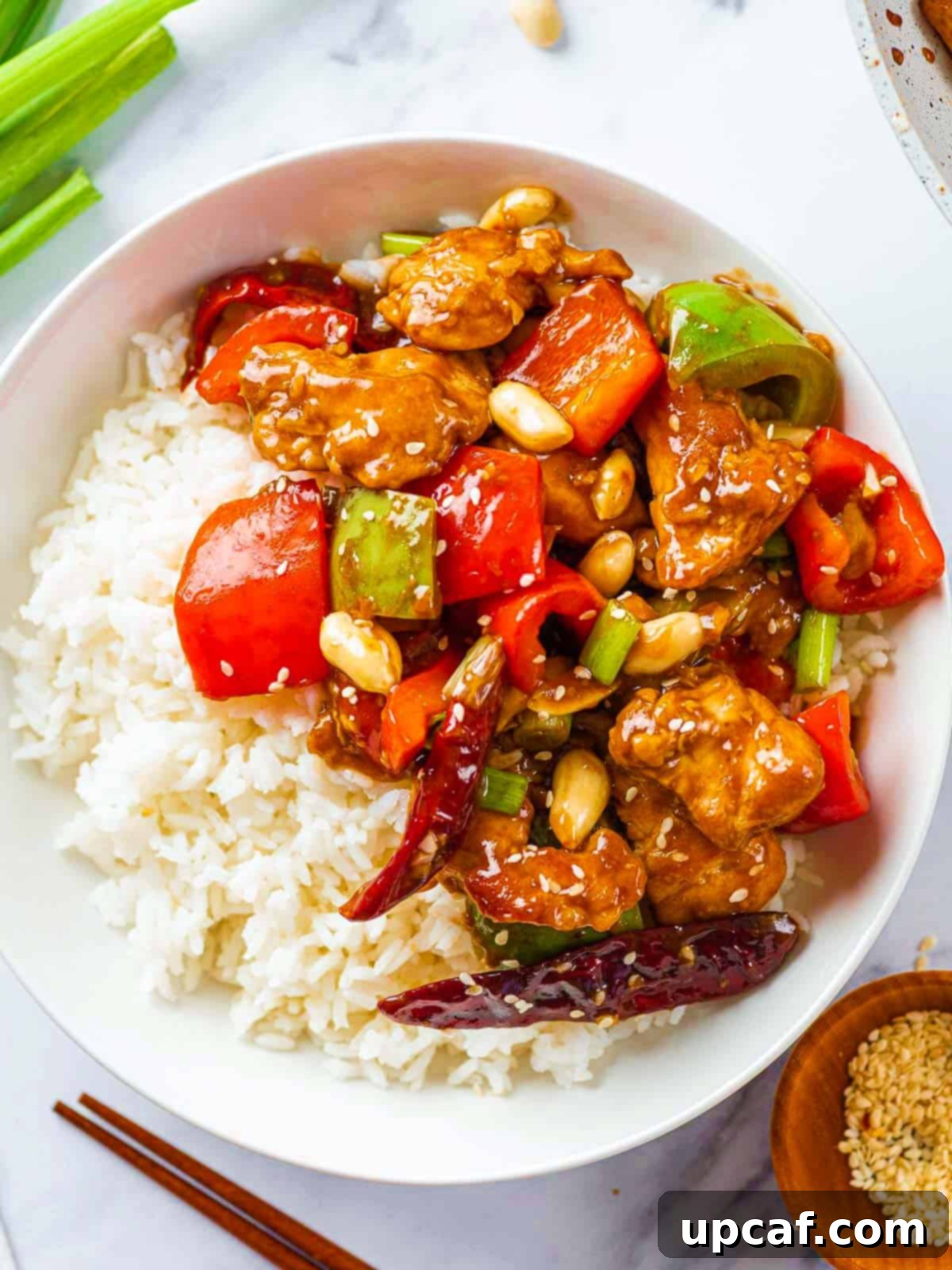
What is Kung Pao Chicken? Delving into Sichuan’s Famous Stir-fry
Kung Pao Chicken (Gong Bao Ji Ding) is a beloved and iconic dish originating from the Sichuan Province in China. It’s a spicy, sweet, and savory stir-fry featuring succulent pieces of chicken, crunchy peanuts, and a mix of vegetables, all coated in a rich, glossy sauce. The dish is famous for its distinctive flavor profile, characterized by the “mala” (麻辣) sensation – a unique combination of numbing and spicy provided by Sichuan peppercorns (often used in authentic versions, though sometimes omitted or substituted in Western adaptations) and dried red chilies. While the original recipe may call for Sichuan peppercorns, this home-style version simplifies it for wider accessibility while retaining the core flavors.
Traditionally, Kung Pao Chicken is made with diced chicken, stir-fried with peanuts, dried chili peppers, and Sichuan peppercorns, along with other ingredients like green onions and bell peppers. The sauce typically includes a mix of soy sauce, vinegar, sugar, and cornstarch, creating a luscious texture that clings beautifully to the chicken and vegetables. When served over steamed rice, the extra sauce is a pure delight, soaking into every grain and making you reach for a second helping!
Why You Need to Make This Homemade Kung Pao Chicken Tonight
There are countless reasons why this homemade Kung Pao Chicken recipe is poised to become a new family favorite. From its ease of preparation to its tantalizing flavors, it truly offers the best of both worlds – gourmet taste with home-cooked comfort.
Unbeatable Flavor Profile: Sweet, Spicy, and Savory Harmony
- Perfectly Balanced Taste: This Kung Pao Chicken strikes an exquisite balance between its sweet, spicy, and savory notes. The sauce is a symphony of flavors, with a delightful heat from the red chilies that leaves a pleasant warmth on your tongue, perfectly complemented by a hint of sweetness and umami.
Faster Than Takeout, Made at Home
- Quick & Convenient: Don’t underestimate the speed! With just a little bit of prep, this classic takeout dish can be on your table in under 30 minutes of cooking time. It’s an ideal solution for busy weeknights when you want something satisfying without the fuss.
Simple Ingredients, Stunning Results
- Everyday Staples: You’ll be surprised to find that most of the ingredients needed for this recipe are likely already in your pantry or easily found at any local grocery store. No exotic hunting required!
Fully Customizable Heat Level
- Adjustable Spice: While Kung Pao is known for its kick, you are the chef! Feel free to moderate the number of red chilies to tailor the spice level to your exact preference, making it perfect for everyone from heat-lovers to those who prefer a milder flavor.
A Crowd-Pleaser for Any Occasion
- Versatile & Delicious: Whether it’s a casual family dinner or a gathering with friends, this Kung Pao Chicken is always a hit. Its vibrant flavors and comforting appeal make it a dish that everyone will enjoy.
The Essential Ingredients for Authentic Kung Pao Chicken
Creating an authentic and flavorful Kung Pao Chicken starts with selecting the right ingredients. Each component plays a vital role in building the dish’s signature taste and texture.

For the Perfect Chicken Marinade
Marinating the chicken is a crucial step that ensures tender, flavorful results and helps the sauce adhere beautifully.
- Chicken: Boneless, skinless chicken tenders are preferred for their tenderness and quick cooking time, though chicken breasts or thighs can also be used, diced into bite-sized pieces.
- Soy Sauce: Adds a foundational salty and umami flavor.
- Cornstarch: This is the secret to tenderizing the chicken and creating a velvety texture once cooked.
- White Vinegar (or Dry Sherry Wine/Rice Vinegar): Provides a slight tang and helps to further tenderize the chicken.
- Salt: Enhances the overall flavor of the chicken.
Crafting the Signature Kung Pao Sauce
The sauce is the heart of Kung Pao Chicken, bringing together all the sweet, spicy, and savory notes.
- Chicken Broth: Forms the base of the sauce, adding depth.
- Soy Sauce: Essential for that characteristic umami and savory punch. Low-sodium options are great for better control over saltiness.
- Balsamic Vinegar: Adds a rich, tangy, and slightly sweet complexity to the sauce.
- White Vinegar (or Rice Vinegar): Contributes a bright, acidic balance.
- Hoisin Sauce: A sweet and savory Chinese BBQ sauce that adds richness and depth.
- Cornstarch: Acts as a thickening agent, giving the sauce its desirable glossy texture.
- Brown Sugar: Provides sweetness to balance the savory and spicy elements.
- Ginger & Garlic: Freshly minced, these aromatics are vital for building a robust flavor base.
The Stir-Fry & Garnish Elements
These components add texture, color, and the signature kick to the dish.
- Oil: A neutral-flavored oil (like vegetable, canola, or peanut oil) is best for stir-frying at high heat without imparting unwanted flavors.
- Red Chilies: Dried red chilies are key for the authentic spicy kick. You can adjust the quantity based on your heat preference. For a deeper flavor, consider adding a few Sichuan peppercorns (optional).
- Bell Peppers: Yellow and green bell peppers add a pleasant crunch and vibrant color. Red bell peppers can also be used for a sweeter note.
- Green Onions: Used both in the stir-fry and as a fresh garnish, they provide a mild oniony flavor.
- Roasted Peanuts: A defining ingredient for Kung Pao, adding a crucial nutty flavor and satisfying crunch.
- Sesame Seeds: Used as a garnish, they add a subtle nutty aroma and visual appeal.
Step-by-Step Guide: How to Cook Easy Kung Pao Chicken
Making Kung Pao Chicken at home is a straightforward process that yields incredibly rewarding results. Follow these simple steps for a perfect stir-fry every time.
1. Prepare and Marinate the Chicken
Start by preparing your chicken. Cut the boneless, skinless chicken tenders into uniform, bite-sized cubes. In a medium bowl, combine the diced chicken with soy sauce, cornstarch, white vinegar (or dry sherry wine), and a pinch of salt. Toss everything together until the chicken is well coated. Allow the chicken to marinate for at least 10 minutes. This short marinade time is essential for tenderizing the chicken and infusing it with flavor.

2. Whisk Together the Flavorful Sauce
While the chicken is marinating, prepare the signature Kung Pao sauce. In a separate bowl, whisk together the chicken broth, soy sauce (preferably low sodium), balsamic vinegar, white vinegar (or rice vinegar), hoisin sauce, cornstarch, brown sugar, minced ginger, and minced garlic. Stir until all ingredients are fully combined and the cornstarch has dissolved. Set this flavorful sauce aside, ready to be added to your stir-fry.

3. Searing the Chicken to Golden Perfection
Heat a large skillet or wok over medium-high heat and add one tablespoon of neutral oil. Once the oil is shimmering, add the marinated chicken cubes in a single layer, ensuring not to overcrowd the pan. Cook for 5 to 6 minutes, stirring occasionally, until the chicken pieces are beautifully golden brown and cooked through. Overcrowding the pan can steam the chicken instead of searing it, so cook in batches if necessary. Once cooked, transfer the chicken pieces to a clean plate and set aside.

4. Sautéing the Aromatics & Vegetables
Using the same skillet, add the remaining tablespoon of oil. Add the dried red chilies and the cubed bell peppers (yellow and green). Stir-fry for 2 to 3 minutes, allowing the peppers to soften slightly but still retain a pleasant crispness. The chilies will release their aromatic heat into the oil, infusing the dish with its characteristic spice.
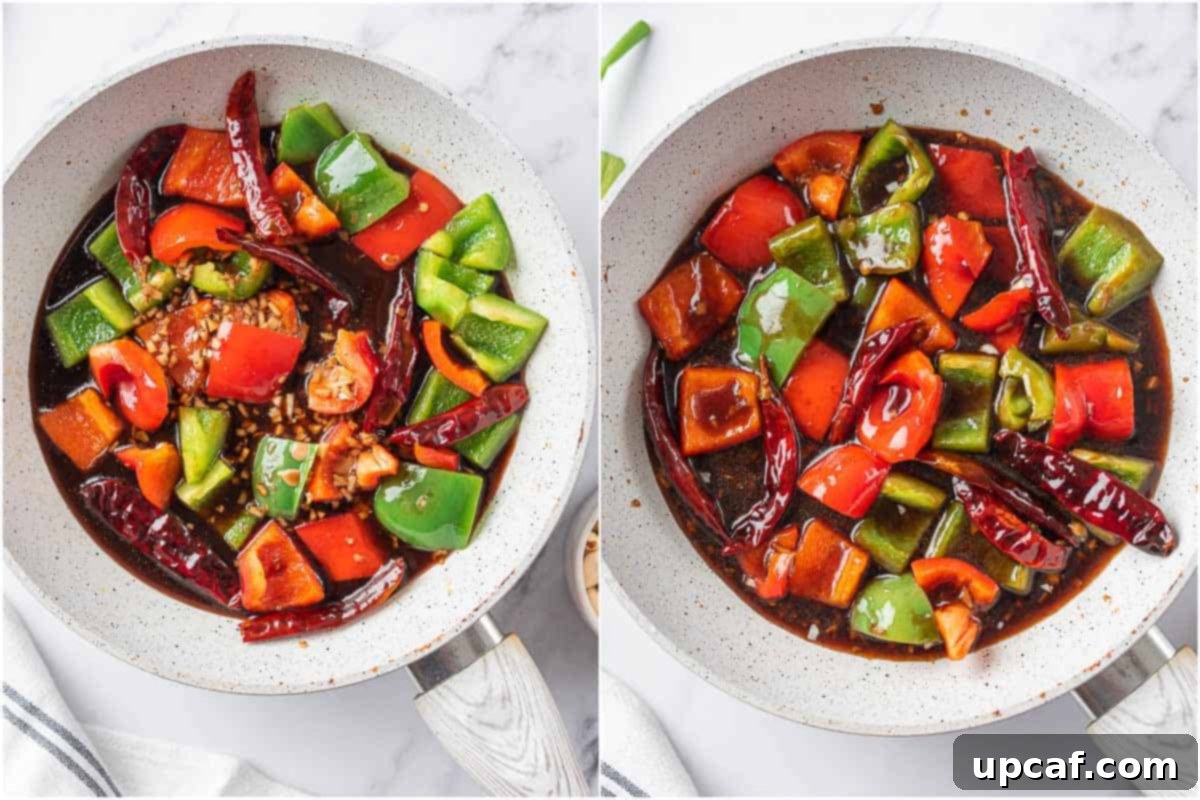
5. Bringing it All Together: The Grand Stir-Fry
Pour the prepared Kung Pao sauce into the skillet with the vegetables. Bring the sauce to a gentle simmer and cook for 3 to 5 minutes, stirring constantly, until the sauce thickens to a glossy consistency. The cornstarch in the sauce will ensure it beautifully coats every ingredient. Once thickened, return the cooked chicken pieces to the skillet. Toss everything together vigorously, making sure the chicken and vegetables are thoroughly coated in the rich, aromatic sauce. Let the chicken simmer in the sauce for another 2 minutes, allowing it to absorb all the wonderful flavors.
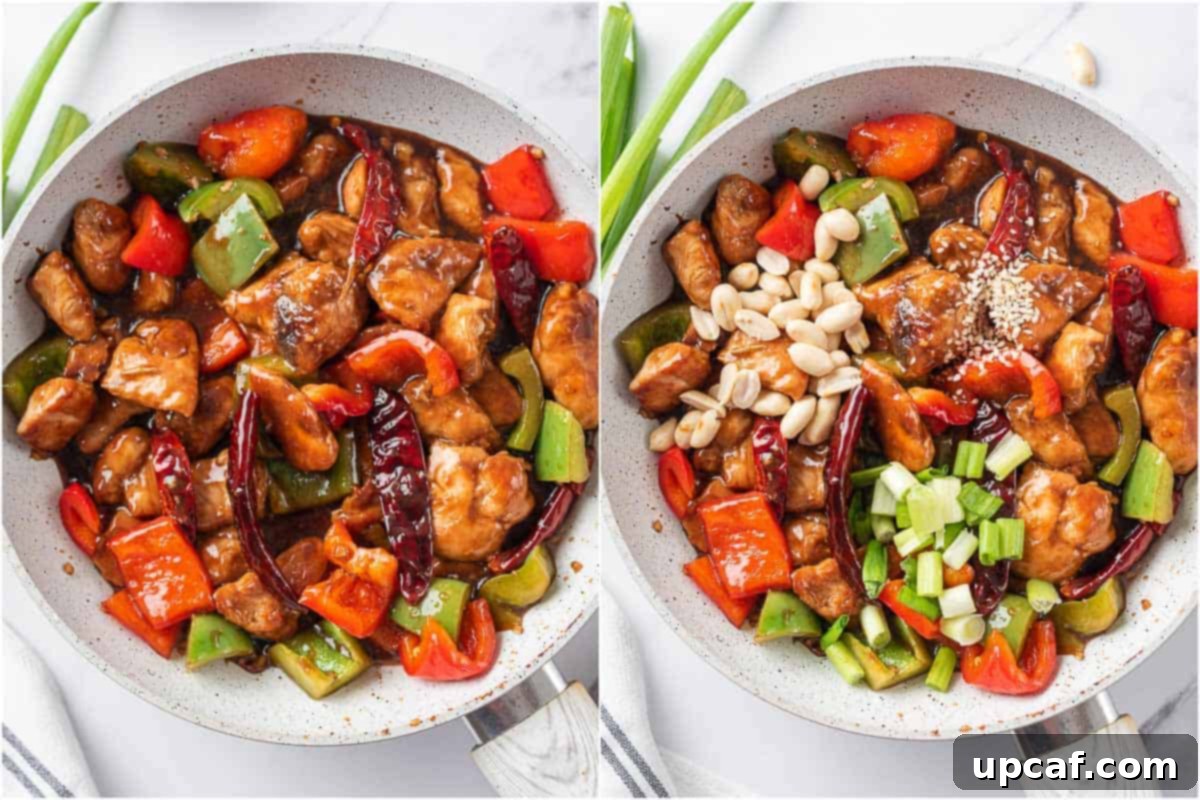
6. Garnish and Serve
To finish, sprinkle in the fresh green onions, crunchy roasted peanuts, and a dash of sesame seeds. Give it a final quick toss to combine the garnishes. Serve your homemade Kung Pao Chicken immediately over a bed of fluffy jasmine rice for a complete and satisfying meal. The interplay of textures and flavors will be absolutely irresistible!
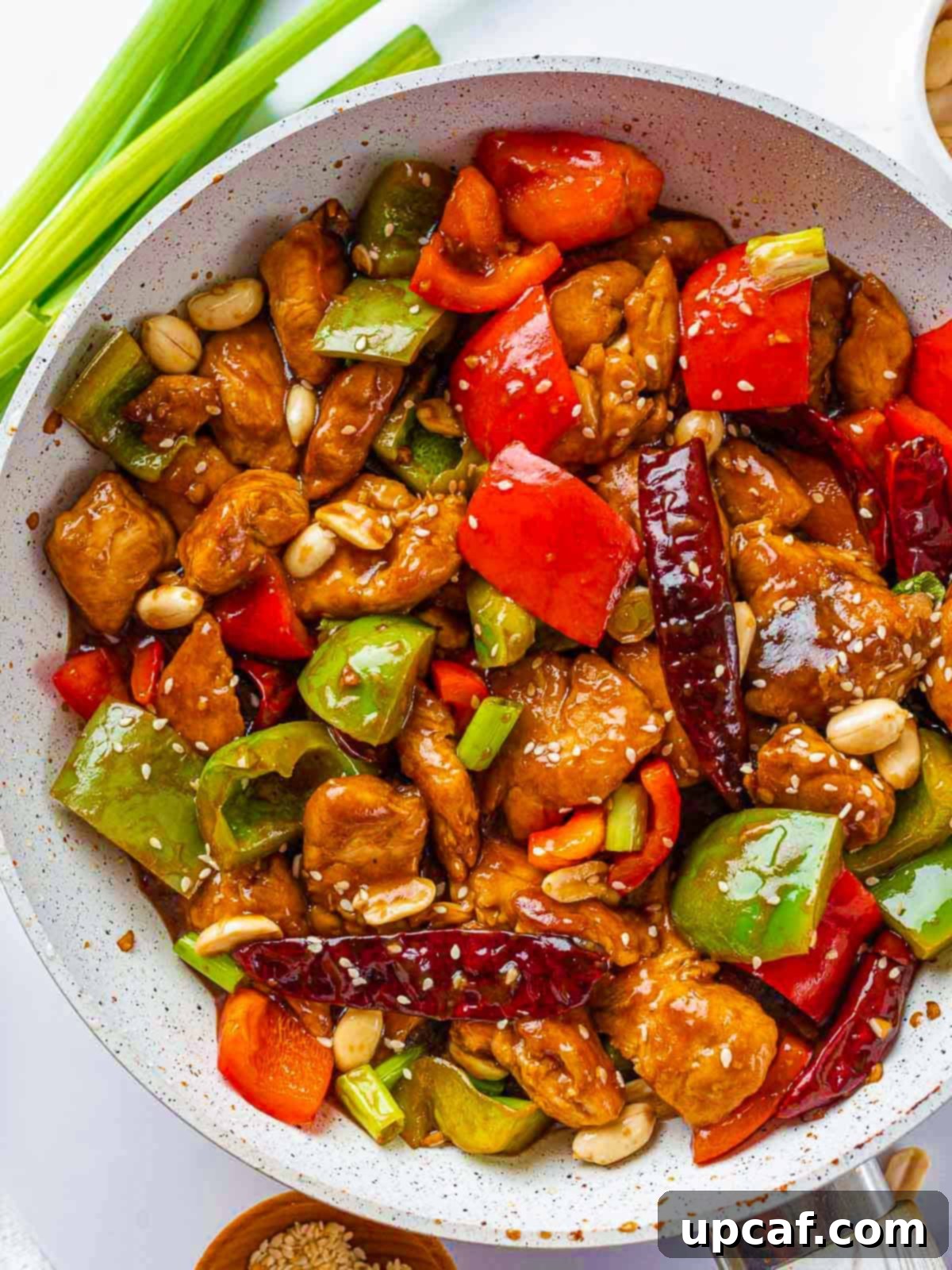
Expert Tips for the Best Homemade Kung Pao Chicken
Elevate your homemade Kung Pao Chicken from good to extraordinary with these expert tips and tricks:
- Control the Heat: For a milder dish, you can use fewer whole red chilies or even remove some of the seeds before cooking. If you desire more heat, feel free to add a pinch of chili flakes along with the whole chilies. For an authentic “mala” (numbing-spicy) kick, add a teaspoon of Sichuan peppercorns to the oil along with the dried chilies.
- Add More Veggies: This recipe is incredibly versatile! Feel free to incorporate other vegetables like sliced zucchini, carrots, broccoli florets, mushrooms, or even snow peas. Add them with the bell peppers to ensure they cook to your desired tenderness.
- Don’t Overcook the Chicken: Chicken tenders cook quickly. Stick to the recommended 5-6 minutes of searing. Overcooking will result in dry, chewy chicken, which nobody wants!
- Roast Your Own Peanuts: While pre-roasted peanuts work fine, fresh roasting can make a huge difference in flavor and crunch. Simply add raw, unsalted peanuts to a dry skillet over medium heat and toast for 3 to 5 minutes, stirring frequently, until fragrant and lightly browned. Let them cool before adding.
- Uniformly Cut Chicken: Ensure your chicken is cut into evenly sized, bite-sized pieces. This promotes even cooking and makes for a more pleasant eating experience.
- Use the Right Cookware: A large non-stick pan, skillet, or traditional wok is ideal for stir-frying. A wider surface area allows for better searing and prevents the ingredients from steaming.
- Mise en Place is Key: “Mise en place” means having all your ingredients prepped and ready before you start cooking. Stir-frying is a fast process, so having everything measured, chopped, and mixed beforehand will ensure a smooth and successful cooking experience.
- Serving Suggestions: While jasmine rice is a classic accompaniment, don’t limit yourself! This dish also pairs wonderfully with cauliflower rice for a low-carb option, basmati rice, quinoa, or even stir-fried noodles. For a healthier meal, serve with a side of steamed broccoli or edamame.

Frequently Asked Questions About Kung Pao Chicken
My homemade Kung Pao sauce is crafted from a delicious blend of chicken broth, soy sauce, balsamic vinegar, white vinegar (or dry sherry wine/rice vinegar), hoisin sauce, cornstarch, brown sugar, fresh ginger, and garlic. This combination creates a rich, complex flavor profile.
Leftovers can be safely stored in an airtight container in the refrigerator for up to 3 days. To prevent sogginess from condensation, ensure the chicken cools completely to room temperature before placing it in the fridge.
While technically possible, I generally don’t recommend freezing this particular recipe. The texture of the vegetables and the chicken can change upon thawing, and the sauce may lose some of its vibrant quality. Since this Kung Pao Chicken comes together so quickly, it’s best enjoyed fresh.
This versatile dish pairs beautifully with a variety of sides. My personal favorite is fluffy jasmine rice, but you can also serve it with cauliflower rice for a low-carb option, basmati rice, quinoa, stir-fried noodles, or even light lettuce wraps. To make the meal even healthier, consider adding a side of steamed greens like broccoli or edamame.
Kung Pao is actually a classic and highly recognized dish within Szechuan (Sichuan) cuisine. Therefore, the main distinction is that Kung Pao is a specific recipe, whereas Szechuan refers to a broader regional culinary style known for its bold, spicy, and often numbing (mala) flavors. All Kung Pao chicken is Szechuan style, but not all Szechuan dishes are Kung Pao.
Absolutely! The heat level is fully adjustable. To reduce the spiciness, simply use fewer dried red chilies, or for a very mild version, you can even omit them entirely. You can also remove the seeds from the chilies before adding them, as the seeds contain most of the capsaicin.
For stir-frying, it’s best to use a neutral-flavored oil with a high smoke point. Good options include vegetable oil, canola oil, peanut oil, or grapeseed oil. These oils won’t overpower the delicate flavors of the Kung Pao sauce and can withstand the high heat required for proper stir-frying.
More Delicious Asian-Inspired Recipes to Explore
If you loved this Kung Pao Chicken, you’ll surely enjoy exploring these other fantastic Asian-inspired dishes:
- Baked Teriyaki Salmon
- Easy Chicken Lo Mein
- Spicy Sriracha Chicken
- Easy Orange Chicken Recipe
- Paneer Pasanda
I genuinely hope you find joy in preparing and savoring all the recipes I share, especially this vibrant and delicious homemade Kung Pao Chicken. Please give it a try, enjoy the process, and don’t hesitate to share your thoughts!
If you try this recipe and find it delightful, please consider leaving a star rating and a comment below. Share your delicious recreations with me on Instagram using my hashtag so I can see your culinary masterpieces! And be sure to follow Cookin’ With Mima on FACEBOOK |INSTAGRAM |PINTEREST for all my latest recipes and social updates. Happy cooking!
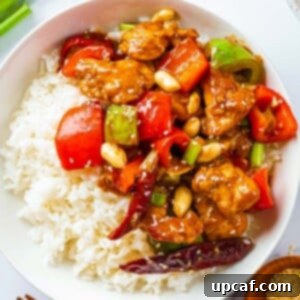
Authentic Kung Pao Chicken
Mariam Ezzeddine
10 minutes
30 minutes
40 minutes
4 servings
Ingredients
To marinate chicken
- 1 lb. chicken tenders
- 2 tbsps. soy sauce
- 2 tbsp. cornstarch
- 1 tbsp. white vinegar, or rice vinegar
- Salt to taste
To prepare the sauce
- ½ cup chicken broth
- 3 tbsps. soy sauce, low sodium
- 1 tbsp balsamic vinegar
- 1 tbsp white vinegar, or rice vinegar
- 1 tbsp hoisin sauce
- 1 tsp cornstarch
- 1 tsp brown sugar
- 1 tsp ginger, minced
- 1 tsp garlic, minced
To prepare the chicken stir fry
- 2 tbsps. oil
- 6-8 whole red chilies
- ½ large yellow bell pepper, cubed
- ½ large green bell pepper, cubed
- ½ cup green onions, cut into ½ inch size
- ¼ cup roasted peanuts
- 1 tbsp sesame seeds
Instructions
- Marinate the chicken in a bowl by combining soy sauce, cornstarch, vinegar and salt for at least 10 minutes.
- Meanwhile combine the sauce ingredients in a bowl and keep it ready.
- Heat a skillet on a medium flame with a tablespoon of oil. Add the chicken cubes and cook for 5-6 minutes until golden and transfer the chicken pieces to a plate.
- To the same skillet add the remaining tablespoon of oil; add the red chilis, peppers and cook for 2-3 minutes.
- Add the prepared sauce and cook for 3-5 minutes until the sauce is thickened.
- Stir the chicken back into the skillet and coat the chicken well with the sauce and let the chicken cook in the sauce for 2 minutes.
- Finally add the green onions, peanuts and sesame seeds, toss it and serve with rice.
Notes
- Feel free to leave the whole red chilies and some of the chili flakes to make the chicken less spicy.
- Feel free to add other veggies if you like. Some recommendations are zucchini, carrots, broccoli, mushroom, and cauliflower.
- Do not overcook the chicken or else it will become chewy. 6 to 7 minutes at the most as they’re diced into small bite-sized pieces.
- You can roast your own peanuts by adding them to a skillet over medium heat then toast it for 3 to 5 minutes, stirring frequently.
- Cut your chicken into even, bite-sized, pieces so they’ll cook evenly.
- Use a large non-stick pan/skillet or wok.
Nutrition
Carbohydrates: 21g |
Protein: 31g |
Fat: 16g |
Saturated Fat: 2g |
Polyunsaturated Fat: 5g |
Monounsaturated Fat: 8g |
Trans Fat: 1g |
Cholesterol: 73mg |
Sodium: 1261mg |
Potassium: 898mg |
Fiber: 3g |
Sugar: 8g |
Vitamin A: 846IU |
Vitamin C: 149mg |
Calcium: 64mg |
Iron: 3mg
